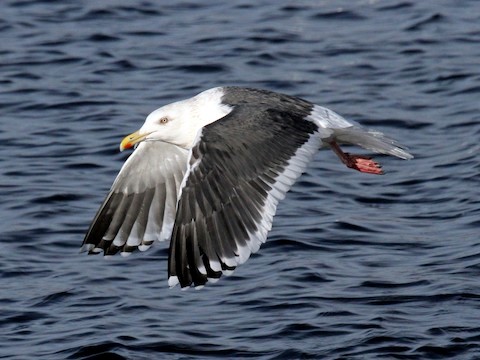Birdfinding.info ⇒ Common and conspicuous along the coasts of northeastern Asia from the Russian Far East to South Korea and Japan. Uncommon farther south, including Hong Kong and Taiwan. In North America, it is fairly common around the Bering Sea, including Gambell, Nome, the Pribilofs, and the Aleutians.
Slaty-backed Gull
Larus schistisagus
Pacific coasts and islands of northeastern Asia.
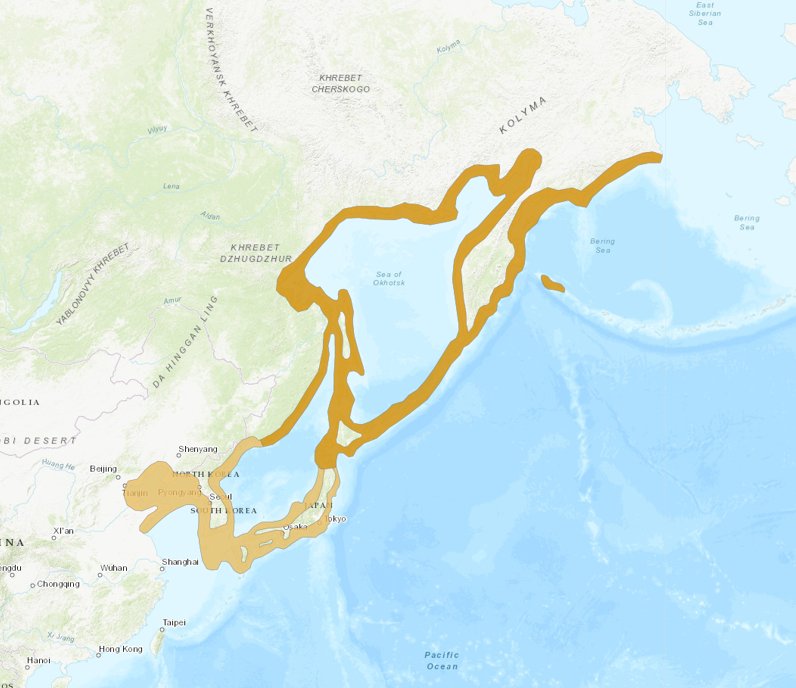
Approximate distribution of the Slaty-backed Gull. © BirdLife International 2018
Breeding. Nests on cliffs and islands from Russia’s Bering Sea coast north to Cape Navarin, and the Sea of Okhotsk, south to North Korea, Sakhalin, Hokkaido, and northeastern Honshu.
Also widespread during summer and fall along coasts and islands throughout the Bering Sea, and regular in small numbers along the northern and southern coasts of Alaska.
Nonbreeding. Winters mainly along coasts from the Sea of Okhotsk and Kamchatka south to the Korean Peninsula and Japan. Small numbers move west to the Yellow Sea coasts of China, and south to Hong Kong and Taiwan. Casual south to Luzon, the Gulf of Thailand, the Marianas, and Hawaii.
Regular in fall and winter in small numbers along the Pacific Coast of North America from Alaska to California.
Fall and winter vagrants have been discovered throughout North America, annually around the Great Lakes, the northeastern coast of the U.S., and the Maritime Provinces, and more sporadically across the interior and south to the Gulf of Mexico—to Brownsville, Texas, and Key West, Florida. A few of these individuals have returned to winter at the same location for several consecutive years.
Vagrants have also been documented on multiple occasions in northern Europe, with records from Iceland, Ireland, England, and Finland.
Identification
A large, dark-mantled gull with pink legs, and a distinctive white “string of pearls” between the gray and black in its wingtips.

Slaty-backed Gull in breeding plumage. (Rausu, Hokkaido, Japan; February 14, 2018.) © David Provencher
Adult Plumages. Adults have a slaty-gray mantle, generally darker than other gulls that normally occur with it. The tone is most similar to Western Gull (occidentalis), but is variable enough to resemble several species—but most of the others have yellow legs, whereas Slaty-backed’s legs are pink, often vivid, bubblegum pink.
Slaty-backed differs from all other dark-backed gulls in having the most prominent white “moons” on its middle primaries. It also has a broad white trailing edge on the secondaries.

Slaty-backed Gull, third-summer, showing white “string of pearls” between the gray and black on the middle primaries. (Marina State Beach, Marina, California; March 14, 2019.) © Blake Matheson
Adult Slaty-backeds in winter plumage typically have extensive streaking over the entire head and neck, often forming a streaked hood that extends onto the back and chest. Many develop dark blotches around the eyes—which creates a striking effect on pale-eyed individuals.

Slaty-backed Gull, winter adult, with a full hood of dark streaks. (Rausu, Hokkaido, Japan; February 14, 2018.) © Nick Bonomo
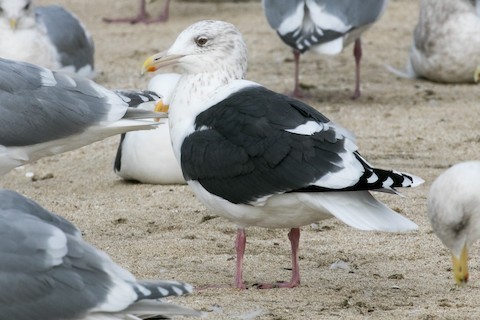
Slaty-backed Gull, winter adult, darker than average—appearing almost black-backed. (Half Moon Bay, California; January 14, 2020.) © Alvaro Jaramillo
The irises are usually pale-yellow, but can sometimes be dull-olive or brownish. The orbital skin is usually pink, but sometimes essentially colorless.

Slaty-backed Gull, winter adult, showing pale iris with dark shadow. (R.K. McMillan Park, Mississauga, Ontario; September 24, 2020.) © Pat Hare
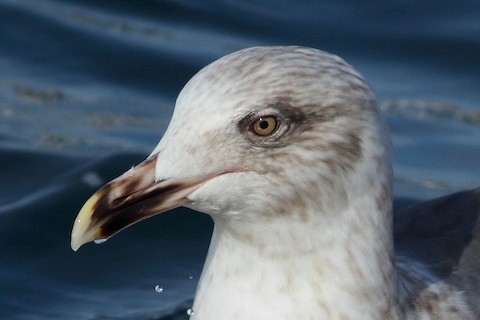
Slaty-backed Gull, third-winter, with dull-olive irises. (Gloucester, Massachusetts; February 19, 2018.) © Frank Lehman
Immature Plumages. Juveniles are medium-brown with bold spots on the mantle and wing coverts. The bold spots usually wear off in November.

Slaty-backed Gull, juvenile or first-winter. (Beppu, Oita, Kyushu, Japan; November 8, 2009.) © Ayuwat Jearwattanakanok

Slaty-backed Gull, juvenile or first-winter. (Cape Nosappu, Nemuro, Hokkaido, Japan; December 26, 2013.) © Ian Davies
First-winter and first-summer birds are mostly pale-brown overall, except on the wings and tail. They become especially pale going into the first summer, then variably blotchy as a few dark-gray feathers grow in.
On the spread wing, first-year Slaty-backeds show the same pattern typical of first-year Herring Gulls: dark-brown primaries, primary coverts, and secondaries, with a distinctly paler “window” on the inner primaries.
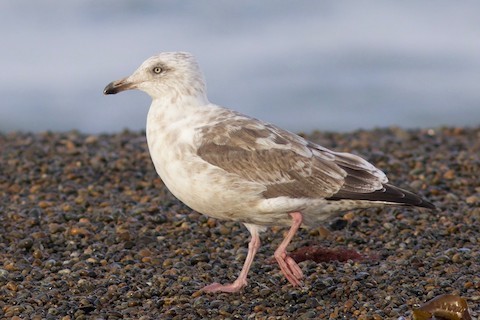
Slaty-backed Gull, first-summer. (Gambell, St. Lawrence Island, Alaska; September 20, 2016.) © Cory Gregory

Slaty-backed Gull, first-summer. (Nome, Alaska; July 15, 2016.) © Bryce Robinson
The tail feathers are mostly dark-brown. The rump, uppertail coverts, and the bases of the outer tail feathers are mostly pale with dark barring (resembling European Herring and Vega Gulls).
Subadult Plumages. Subadults from second-winter to third-winter are mostly pale, with dark-gray on the back, a pale rump, and a mostly blackish tail.
The wings typically turn pale in the second-summer plumage, before the dark-gray feathers grow in.
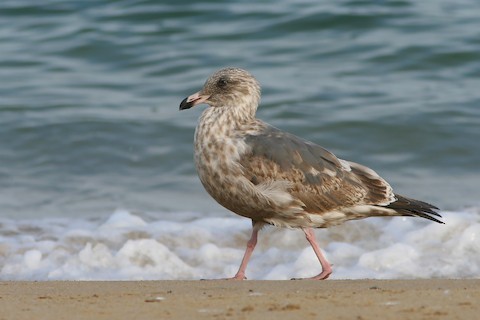
Slaty-backed Gull, second-winter. (Beppu, Oita, Kyushu, Japan; November 8, 2009.) © Ayuwat Jearwattanakanok
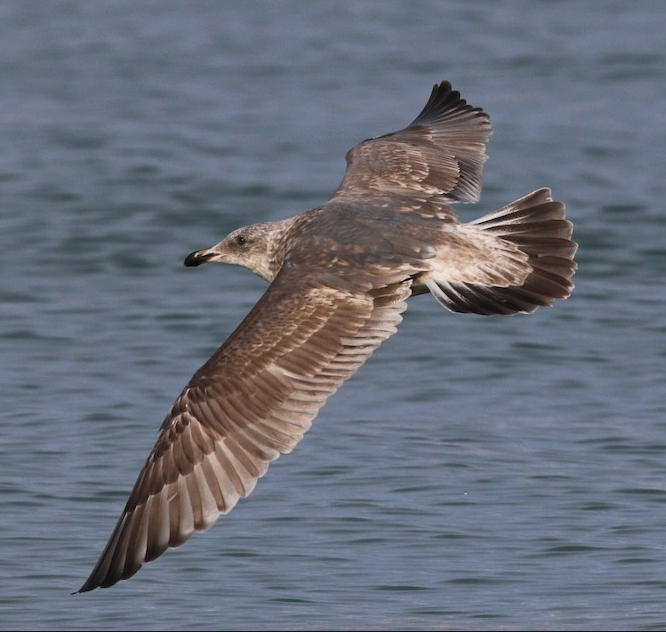
Slaty-backed Gull, second-winter. (Cape Nosappu, Nemuro, Hokkaido, Japan; December 26, 2013.) © Ian Davies
As with adults, winter subadults vary in the amount of streaking they develop over the head, neck, and chest.
By the third winter, subadults resemble adults, but with a black subterminal ring on the bill and traces of black in the tail.

Slaty-backed Gull, second-summer. (Nome, Alaska; June 15, 2018.) © Tom Johnson

Slaty-backed Gull, third-winter. (Qualicum Beach, British Columbia; March 23, 2021.) © Liam Singh
Notes
Monotypic species.
See below for comparisons of the Slaty-backed Gull with Western and Great Black-backed Gulls.
Cf. Western Gull. Adult Slaty-backed and Western Gulls have approximately the same mantle and leg coloration, and immatures can be generally similar at most stages. Slaty-backed has become a somewhat regular visitor to Western’s range along the Pacific Coast from British Columbia to California, and Slaty-backed is more likely to wander to most other parts of North America.
Slaty-backed is best identified by the white “string of pearls” in its middle primaries—a strip of white subterminal spots between the gray and black in the wingtip. Western Gull usually has more black and less white in its wingtip, typically limited to small terminal spots and a single white window on the outermost primary.
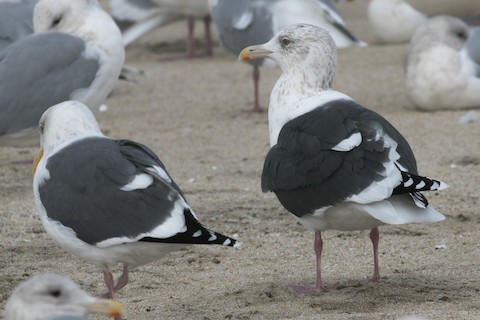
Slaty-backed Gull (right) with Western Gull, showing near-identical overall coloration. (Half Moon Bay, California; January 14, 2020.) © Alvaro Jaramillo
Cf. Great Black-backed Gull. Slaty-backed and Great Black-backed Gulls are both very large and have dark-gray mantles and pink legs. They do not normally overlap, but Slaty-backed has become a somewhat regular vagrant to eastern North America, especially the Great Lakes and Northeast.
Overall, Great Black-backed is more blackish and the gray on Slaty-backed has a slightly bluer tone. In winter plumage—from around September to January—Slaty-backed typically has extensive streaking on its head, neck, and chest, whereas Great Black-backed remains almost entirely unstreaked.
Slaty-backed’s most diagnostic feature is the white “string of pearls” in its middle primaries—a strip of white subterminal spots between the gray and black in the wingtip. However, Great Black-backed Gull’s wingtips often show weaker version of the same pattern, so the difference is a matter of proportion. Great Black-backed typically has larger white spots at the tips of its two outer primaries.

Slaty-backed Gull (background) with Great Black-backed Gull—note lean white head. (Quidi Vidi Lake, St. John’s, Newfoundland; February 16, 2021.) © Blair Dudeck
More Images of the Slaty-backed Gull

Slaty-backed Gull, winter adult appearing comparatively pale-mantled. (Calumet Park, Chicago, Illinois; January 9, 2018.) © Carl Giometti

Slaty-backed Gull in breeding plumage, a relatively pale-mantled adult. (Umara Island, Taui Bay, Magadanskaya Oblast, Russia; June 18, 2008.) © Lars Petersson

Slaty-backed Gull, winter adult showing extensively streaked head and neck. (Quidi Vidi Lake, St. John’s, Newfoundland; February 16, 2021.) © Blair Dudeck
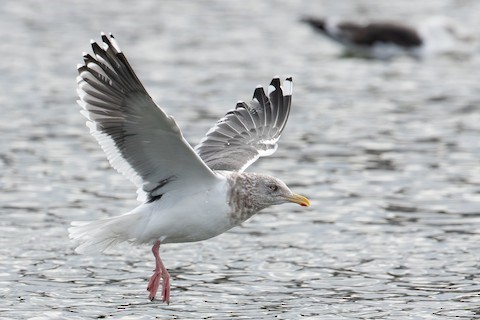
Slaty-backed Gull, winter adult, showing white “string of pearls” between the gray and black on the middle primaries—visible on both the upperside and the underside. (Quidi Vidi Lake, St. John’s, Newfoundland; February 16, 2021.) © Blair Dudeck

Slaty-backed Gull, winter adult. (Tracy, California; February 18, 2019.) © Jim Gain

Slaty-backed Gull, winter adult showing pale eye with black shadow. (Fort Pickens, Florida; November 16, 2021.) © Brenda Callaway

Slaty-backed Gull, third-winter. (Gloucester, Massachusetts; February 19, 2018.) © Sean Williams
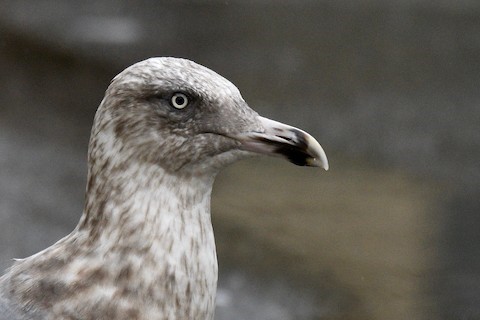
Slaty-backed Gull, third-winter, showing pale eye staring out of heavily streaked head. (Clallam Bay, Washington; October 26, 2021.) © Will Brooks

Slaty-backed Gull, first-winter. (Cape Nosappu, Nemuro, Hokkaido, Japan; December 27, 2013.) © Ian Davies
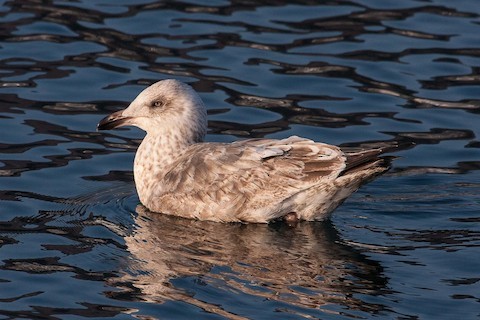
Slaty-backed Gull, first-winter. (Hakodate, Hokkaido, Japan; February 22, 2009.) © Eric VanderWerf

Slaty-backed Gull, first-summer. (Gambell, St. Lawrence Island, Alaska; September 6, 2021.) © Buzz Scher
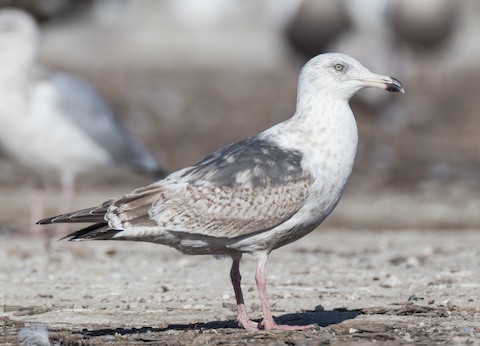
Slaty-backed Gull, second-winter. (Marina Landfill, Marina, California; February 6, 2018.) © Blake Matheson
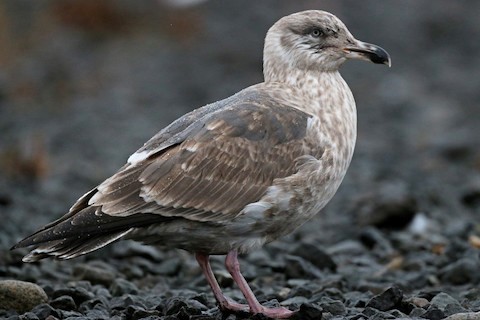
Slaty-backed Gull, second-winter. (Cape Nosappu, Nemuro, Hokkaido, Japan; December 27, 2013.) © Ian Davies
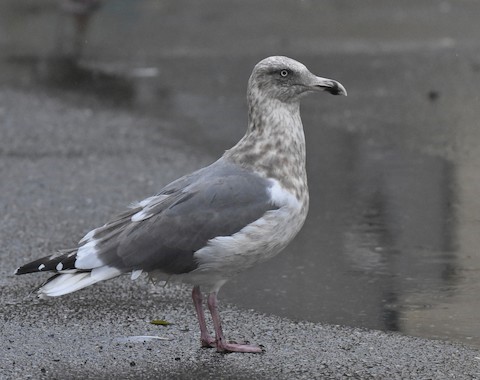
Slaty-backed Gull, third-winter. (Clallam Bay, Washington; October 26, 2021.) © Jason Vassalo
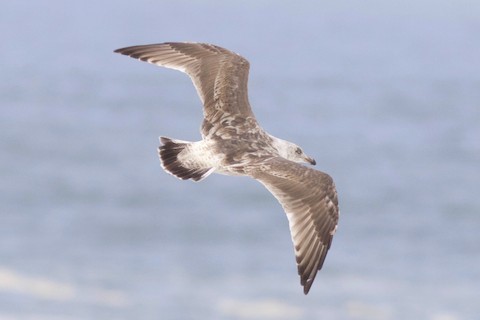
Slaty-backed Gull, first-summer. (Gambell, St. Lawrence Island; September 20, 2016.) © Cory Gregory

Slaty-backed Gull, juvenile. (Gambell, St. Lawrence Island, Alaska; September 20, 2016.) © Cory Gregory

Slaty-backed Gull, second-winter. (Cape Nosappu, Nemuro, Hokkaido, Japan; December 26, 2013.) © Ian Davies
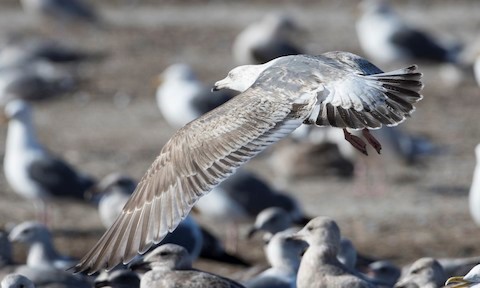
Slaty-backed Gull, second-winter. (Marina Landfill, Monterey, California; February 6, 2018.) © Brian Sullivan
References
Alderfer, J., and J.L. Dunn. 2014. National Geographic Complete Birds of North America (Second Edition). National Geographic Society, Washington, D.C.
BirdLife International. 2018. Larus schistisagus. The IUCN Red List of Threatened Species 2018: e.T22694362A132544713. https://dx.doi.org/10.2305/IUCN.UK.2018-2.RLTS.T22694362A132544713.en. (Accessed February 11, 2022.)
Brazil, M. 2009. Birds of East Asia. Princeton University Press.
eBird. 2022. eBird: An online database of bird distribution and abundance. Cornell Lab of Ornithology, Ithaca, N.Y. http://www.ebird.org. (Accessed February 11, 2022.)
Harrison, P. 1983. Seabirds: An Identification Guide. Houghton Mifflin, Boston.
Howell, S.N.G., and J.L. Dunn. 2007. Gulls of the Americas. Houghton Mifflin, Boston.
Olsen, K.M., and H. Larsson. 2003. Gulls of North America, Europe, and Asia. Princeton University Press.
Pyle, R.L., and P. Pyle. 2017. The Birds of the Hawaiian Islands: Occurrence, History, Distribution, and Status. Version 2 (January 1, 2017). http://hbs.bishopmuseum.org/birds/rlp-monograph/. B.P. Bishop Museum, Honolulu, Hawaii.
Sibley, D.A. 2014. The Sibley Guide to Birds (Second Edition). Alfred A. Knopf. New York.
Xeno-Canto. 2022. Slaty-backed Gull – Larus schistisagus. https://xeno-canto.org/species/Larus-schistisagus. (Accessed February 11, 2022.)
